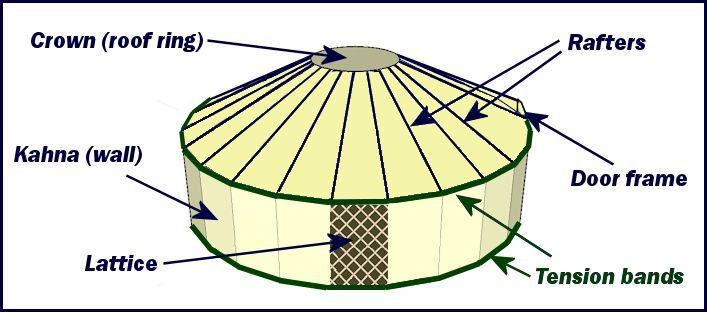Pool domes
Click here or the image to see what pool domes looked like in 1966
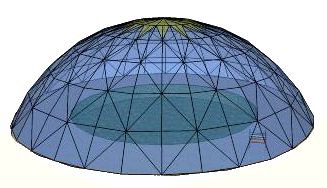
A geodesic pool dome is a good idea. You’ll be more comfortable in warmer water a covered dome offers, and you’ll enjoy a longer season. And since it only needs to support its own weight and a cover, you don’t need a heavy-duty pipe or large lumber struts.
Depending on the cover used, your geodesic pool dome can become a solar collector and shade at the same time. When not in use, a closed dome will trap heat inside it and the water from the pool serving as a heat collector. When you want to go for a swim, open up the entrances for a breeze and enjoy warmer water than usual!
In most areas a geodesic dome will be considered as a temporary structure by your local authorities, so you may not need any permit to build and use it (always check with your authorities!). Most pools are up to 30 feet in diameter, a size that lends to making your geodesic pool dome out of 3/4″ EMT pipe or 2″ X 4″ lumber. But if you go with lumber, don’t expect he inspector to buy your “temporary structure” argument.
Note that in some areas anything over a certain square footage requires a permit. On the other hand getting the permit should not be a big deal as the requirements are often to submit a drawing of the dome and location on your property.
Yurt: alternative to a geodesic pool dome
A pool cover structure does not need to be a geodesic dome. In fact, a yurt structure may be easier to build for most people.
- There are no supports other than around the perimeter
- The roof is held into place with a central ring to which rafters are attached.
- Covering a yurt is simpler. You can use transparent or opaque fabric.
- Can be made as a transportable structure
Choosing between a geodesic dome or a yurt to cover your swimming pool is a personal decision but also dependent on the area to cover. Each solution has merits.
For more information on yurts, click here
Cover and shade
Many will first think of using poly film found at the hardware store because it’s inexpensive, see-through, and easy to work with. But there are problems with that material: it may not last the season, and almost certainly won’t last for the next.
That’s because poly film does not breathe and it disintegrates under UV radiation. By the time Fall comes around or within 5-6 months, that cheap covering will show signs of weaknesses. Add to that human interaction and you’re sure to rip it off at the end of the season. It is also a lousy solution for shade since it offers little.
For a clear see-through cover, PVC plastic or PVC canvas is the way to go for a pool dome, but except to pay approximately $1 per square foot. For a 25-foot pool dome that comes to $1000 before sewing the sections together and making the entrance and windows.
Shrink wrap to cover your pool dome
Clear shrink wrap is much less expensive (for that same 25-foot dome the cost is approximately $200 for 9mil thickness; 7mil is what they use to cover boats so your pool cover would be stronger). But then there is the cost of shrinking the material with a heat gun. If you are lucky, a tool rental business will have the equipment and the work can be done in one day. Your dome cover will be tight as a drum.
Windows for ventilation
The simplest solution is to make windows the size of a triangle: the area is cut out but enough material is left so that it will wrap around the struts and held into place with shrink wrap tape. How to cover the hole is up to you. Consider gluing Velcro strips so you can remove your window covers/”curtains” at will.

Lastly, shrink wrap can last up to 2 years. You can easily take down the old cover and recycle it (most shrink wrap can be recycled), but it is a recurring cost, though much less than a PVC cover.
Premium cover solution: polycarbonate panels
Polycarbonate panels are what many greenhouses are covered with, but it is very expensive and cannot be easily attached to a conduit dome. A timber dome is the preferred material for panels. If you are considering using polycarbonate panels, then you should contact a professional. This can end up costing a lot of money.
Instead of going through all variations of cover on this page, please see our coverings section on this site.
If you want to calculate the sections (a.k.a. gores) to make your cover, please visit the geodesic dome cover calculator page.
Whether you build a pool dome from timber or metal pipe, it’s a good idea to make your cover removable. The worries of heavy snow loads aren’t worth the hassle. If a tear occurs you can take down the cover easily and make repairs.
Another reason for a removable pool dome cover: because you go from a temporary to a permanent structure, you’d have to get an engineering seal and reinforce your entire dome to please the authorities and get a much more expensive and stronger cover. The average pool owner should simply take the cover off until the next season.
Other considerations for a pool dome
Clearance
This is a very important safety factor. People jump into the pool, they want to hang on to the dome and drop in the water and kids being kids run around everywhere. Some localities specify a certain clearance of any structure from the pool. most will insist on an enclosed area. By making a pool dome you can plan for how much space there is from the pool to the wall of the dome, and as a plus, use the geodesic dome as the required enclosure thereby eliminating the cost of an expensive fence project around the pool.
Attaching the structure to the ground
Since most pools are in the backyard of homes, your pool is surrounded by a flat area of grass. You have various choices to keep your pool dome from flying away during strong winds:
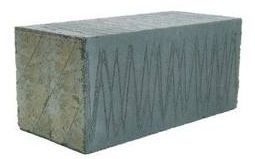 Cement blocks: these would require to be fairly large if you have a large dome. For instance a deck block at every vertex (where struts meet) may work for a small 15′ dome but would be insufficient for a 30-foot structure.
Cement blocks: these would require to be fairly large if you have a large dome. For instance a deck block at every vertex (where struts meet) may work for a small 15′ dome but would be insufficient for a 30-foot structure.
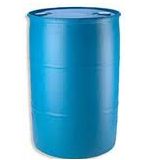 Barrels: by these we mean the big ones, about 3 feet high and filled with water, dirt, sand or even gravel located around the dome and attach to the struts, preferably at the vertices.
Barrels: by these we mean the big ones, about 3 feet high and filled with water, dirt, sand or even gravel located around the dome and attach to the struts, preferably at the vertices.
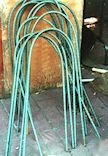 Rebar canes: this is a method used by many at Burning Man to secure their dome or tent. You take a 4-5 foot piece of rebar, bend it like a candy can then hammer it down into the ground all around the perimeter of the pool dome.
Rebar canes: this is a method used by many at Burning Man to secure their dome or tent. You take a 4-5 foot piece of rebar, bend it like a candy can then hammer it down into the ground all around the perimeter of the pool dome.
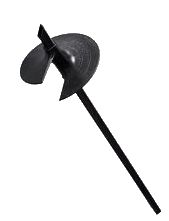 Ground screws: probably the best solution as these are literally screwed into the ground 2-4 feet. Again, having an attachment point at every vertex is the smart thing to do. They can be taken out of the ground and placed somewhere else. No need to make holes in the ground, but you will need strength to screw them all the way down. You can rent the machine to do this at you local hardware place.
Ground screws: probably the best solution as these are literally screwed into the ground 2-4 feet. Again, having an attachment point at every vertex is the smart thing to do. They can be taken out of the ground and placed somewhere else. No need to make holes in the ground, but you will need strength to screw them all the way down. You can rent the machine to do this at you local hardware place.
Entryways
There should be at least 2 entrances for the pool dome. It’s just common sense and safe to to so. You can get more information on making doors on this page.
Ventilation
Having a geodesic dome that warms your pool is nice, except that the average person swims in the daytime, and if you want to take a dip in the evening, keep in mind the stored energy in the pool starts to escape when the cool air moves in at night and without proper ventilation ambient air warms up.
If you made your pool dome with 2 entrances, it’s likely this will not be an issue as you can open or close them to your liking. Still, the hot sun at mid-day may turn your pool area into a a giant sauna.
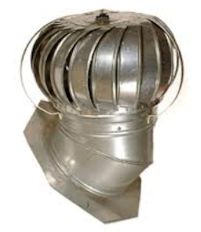 |
 |
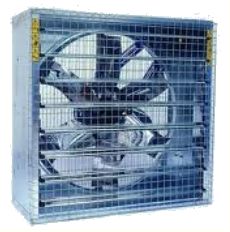 |
| A wind turbine atop your dome will naturally exhaust hot air as it rises | An electrical fan forces air in or out of the dome. | An exhaust box connected to the dome through an air conduit can displace large amounts of air quickly. |
You could arrange to bring forced air from the outside. If you have a shaded area close by, get a square ventilator and attach it to a flexible ventilation conduit that connects to your dome at approximately 6′-8′ high (or 2-3 meters). The reason to put this so high is so no one screws around with it and it’s comfortable to receive cooler air from above!
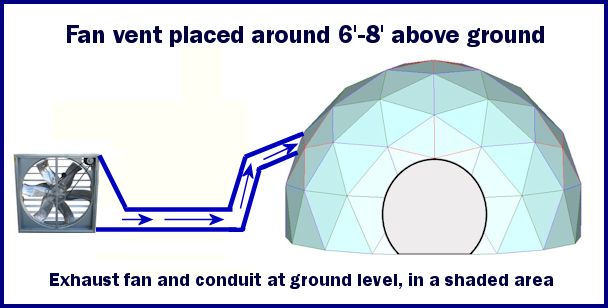
But the one ventilation hole you should have is at the top of the dome to exhaust the hot air just as is done for an attic.
Absolutely do not try to install anything electric such as a ceiling fan to your dome above the pool. Same goes for lighting. If you do want to install a fan and some lights, put them at the furthest distance from the pool attached very strongly to the dome.



